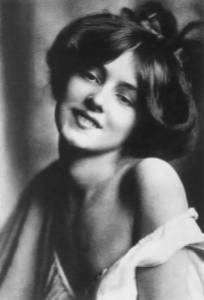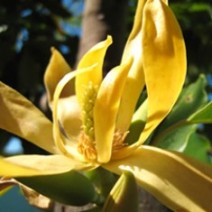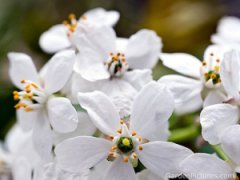
Evelyn Nesbit (1884-1967) in the early 1900s.
She was a dark-haired beauty with alabaster skin and a thick mane of hair worn like a Gibson Girl. Her dazzling smile would have merited attention, had it not been for the mounds of pillowy, white flesh that almost tumbled out of her tight bodice to the great appreciation of the aristocratic men around her. Her skin was scented with orange blossom neroli, as spicy, peppered and lush as her reputation, and with amber as darkly golden as the velvet curtains of the theatre box where she held court. Her patron and lover sniffed the aroma appreciatively. It was a marked contrast from the dainty, simple, very prim, floral scents of the other women in his lives, from his fiercely proper Victorian mother who was one of society’s leading matrons, to his retiring, shy wife, and even the young nannies in charge of their children. No, his mistress went for lush abandon and expensive opulence, as was her style, and she wore Grossmith‘s Phul-Nana.

The luxury, limited-edition Phul-Nana Baccarat flacon.
Grossmith is a very old British perfume house. The Perfume Shrine explains that it was “originally established in 1835 in the coterie of influential perfumeries such as Penhaligon’s, Guerlain, Floris and Creed (who were following the footsteps of Houbigant and Lubin)[.]” The house flourished with royal and international acclaim, creating perfumes for royal bethrothals, and receiving royal warrants from various European royal families. As Senteurs d’Ailleurs puts it, Grossmith “rivalled many French houses around the turn of the century. [Then, it] lost its way after the Second World War, going down market and selling synthetic perfumes in the mass market.” By 1970, the house was in serious trouble, and, by 1980, it was sold out of the family’s hands.

Amanda and Simon Brooke. Source: The Perfume Magazine.
Then, one day, around 2005, a man called Simon Brooke was researching his genealogical background, and discovered that he was the great, great grandson of Grossmith’s founder, John Grossmith. A fantastic newspaper article in the Telegraph, entitled “Grossmith: scent by descent” charts what happened next. In 2007, Mr. Brooke decided to buy back the company, return it to the family, and revive it with the help of the legendary Roja Dove, perhaps one of the most famous perfumers alive. “The original plan was to revive the perfume house using Dove as the nose, remastering the perfumes based on photochromatographic analysis of antique samples.” In 2008, however, Mr. Brooke met a distant Grossmith relative, and found that he had old ledgers containing 300 of Grossmith’s perfume formulae which he had rescued from Grossmith’s offices during the 1940s Blitz. It changed everything. As the Telegraph explains, Mr. Brooke and his wife followed Roja Dove’s suggestion to commission Robertet (a French fragrance house in Grasse who specializes in very high-quality natural materials) to replicate Grossmith’s three greatest classics, making every effort to hew as closely as possible to the original formula. Money was no object, no matter how great the personal burden and sacrifice:
‘We didnt give Robertet a budget, we just told them to produce it using the best materials.’ Brooke is tightlipped about exactly how much money he and Amanda have invested in the company, but it is a considerable sum. “We sold our holiday home and used our savings.” The resulting fragrances are expensive-smelling floral orientals that bear no resemblance to the bland massmarket concoctions that litter today’s perfume counters.

The new Phul-Nana and its siblings in regular bottles. Source: Fragrantica.
In 2009, Grossmith re-released its three most famous, historical fragrances. One of those fragrances was Phul-Nana. Phul-Nana was originally released in 1891, and caused a storm, soon becoming one of Grossmith’s most beloved fragrances. As the Telegraph article explains, Phul-Nana “was “the Chanel No5 of its day.” Luckyscent puts it into historical context by saying that, when Phul-Nana was originally released, Jicky was brand new, and Jacques Guerlain was just barely out of grade school!

“The Baccarat set of crystals as it looks today, £23,250.” Photo: Grossmith via The Telegraph newspaper.
To celebrate Grossmith’s revival with true style, even two royal families stepped in to help. The Telegraph article says, “The royal families of Oman and Bahrain… invested in the new Baccarat crystal presentation sets of the three scents costing £23,250, made using the original Baccarat crystal moulds from 1919 (tracked down by Brooke when he noticed ledger entries detailing Baccarat orders) and etched with real gold.” I find them to be stunningly beautiful, but then they should be at that price.
The new 2009 Phul-Nana was created by Trevor Nicholl. Like its siblings, it was released in both eau de parfum and pure parfum (or extrait de parfum) concentrations. This review is for the Eau de Parfum. Grossmith describes the fragrance as follows:
Hindi for lovely flower
“A Bouquet of India’s Choicest Flowers”
A fresh, sweet floral composition with aromatic fougere overtones on a soft warm, woody base. Originally created in 1891, this scent is a rare marriage of the herb garden with the flower garden, unusual in a feminine fragrance. It paved the way for the ‘oriental’ fragrances that were to follow.
According to Senteurs d’Ailleurs, the notes include:
bergamot, orange, neroli, geranium, tuberose, ylang ylang, patchouli, benzoin siam, cedarwood, sandalwood, opoponax [sweet myrrh], tonka bean, and vanilla bourbon.
 Phul-Nana opens on my skin as spicy, peppered, herbal flowers. There is geranium which smells fiery, dark, and slightly pungent, followed quickly by neroli. The latter smells exactly like orange blossoms turned spicy, bitter, sweet, slightly herbal, green, and masculine. I should probably explain something about neroli. Both neroli and orange blossoms come from the flowers of the same tree, but the method used to extract the materials differs and, thereby, leads to a slightly different aroma. Steam distillation is used to obtain neroli oil from the blossoms of the bitter Seville orange tree, while distillation with solvents is used to get orange blossom absolute. The latter has a fragrance that is more feminine, indolic, lush, sweet and purely floral than neroli which is more bitter, spicy, green and brisk. Yet, at the end of the day, both ingredients are merely a form of orange blossom, and that is the primary characteristic of Phul-Nana on my skin.
Phul-Nana opens on my skin as spicy, peppered, herbal flowers. There is geranium which smells fiery, dark, and slightly pungent, followed quickly by neroli. The latter smells exactly like orange blossoms turned spicy, bitter, sweet, slightly herbal, green, and masculine. I should probably explain something about neroli. Both neroli and orange blossoms come from the flowers of the same tree, but the method used to extract the materials differs and, thereby, leads to a slightly different aroma. Steam distillation is used to obtain neroli oil from the blossoms of the bitter Seville orange tree, while distillation with solvents is used to get orange blossom absolute. The latter has a fragrance that is more feminine, indolic, lush, sweet and purely floral than neroli which is more bitter, spicy, green and brisk. Yet, at the end of the day, both ingredients are merely a form of orange blossom, and that is the primary characteristic of Phul-Nana on my skin.

Source: Twitter.
At this point, however, Phul-Nana is primarily herbal, peppered geranium followed by bitter, but sweet, neroli, trailed far behind by small flashes of other elements. There is a subtle whiff of lemony bergamot and juicy, blood-orange, both infused with a hint of dark, peppered patchouli. Lurking far below, in Phul-Nana’s depths, is something floral, herbal, and aromatic that almost resembles lavender. The whole fragrant bouquet is wrapped up with sweet, slightly honeyed opononax, or sweet myrrh. Everything feels peppered, bitter, sweet, herbal, floral, and resinous all at once.
 The ensuing result is a very unusual fougère with oriental spiciness and resins. In fact, it seems to be quite rare to have an oriental fougère for women at all. On Fragrantica, as one commentator noted, that there are only five such perfumes listed in the Oriental Fougère database, as compared to 139 for men and 41 unisex fragrances for all. Yet, nothing about Phul-Nana feels as though it’s purely for women. The aromatic, herbal notes which give way to an oriental floral spiciness certainly seem very unisex to me.
The ensuing result is a very unusual fougère with oriental spiciness and resins. In fact, it seems to be quite rare to have an oriental fougère for women at all. On Fragrantica, as one commentator noted, that there are only five such perfumes listed in the Oriental Fougère database, as compared to 139 for men and 41 unisex fragrances for all. Yet, nothing about Phul-Nana feels as though it’s purely for women. The aromatic, herbal notes which give way to an oriental floral spiciness certainly seem very unisex to me.
Twenty minutes into Phul-Nana’s development, the “rare marriage of the herb garden with the flower garden” finally takes place, and the perfume starts to shift. The fragrance is still a highly peppered, spicy combination of geranium-neroli with a herbal facade and dark, bittersweet citrus fruits, but new elements start to appear around the edges that start the transition into a purely oriental scent. There is a tiny whisper of buttery, custardy ylang-ylang in Phul-Nana’s depths, and the amber begins to grow deeper. The bitter edges seem smoothed out, as the fragrance becomes sweeter and warmer. The opoponax seems richer but, also, drier. It has lost that tiny vestige of honeyed sweetness, and is now infused with cedar which adds yet another layer of pepperiness to the spicy mix. When combined with the feel of bitter, sweet, blood orange, the result is a strong visual of orange and black.
Shortly after the end of the first hour, Phul-Nana becomes softer and even warmer. The fragrance seems to fade a little in power, and the notes feel a little less pungent or forceful, but Phul-Nana still a potent, heady, dense bouquet. The neroli orange blossom has now far overtaken the herbal, spicy, peppered geranium, though the combination still remains atop its amber base. There are hints of cedar and patchouli, even occasionally a ghostly pop of ylang-ylang, but I don’t smell any tuberose and absolutely no sandalwood. The absence of both elements never changes, either. In fact, the fragrance seems to lose a lot of its existing nuances over the next few hours. The extremely muted, subtle, herbal hints soon fade away, as does the minuscule trace of ylang-ylang and patchouli. Even the geranium retreats from center stage, becoming a background player to the warmed, amber-infused, neroli orange blossom that takes over as the star of the show.

Evelyn Nesbit in 1902, photo by Gertrude Käsebier.
By the start of the third hour, Phul-Nana is an amber neroli fragrance with a muted, hidden flicker of geranium. If one wanted to be laudatory, one could call it warm, seductive, opulent, and very languid in feel. If one wanted to be critical, then one could say it was simple, and unoriginal. I’ll say that it’s both those things, but done in a manner that feels incredibly classique. Phul-Nana feels like a very expensively made fragrance with very rich ingredients done in the old tradition of classic perfumery to create a simple, elegant, very seductively opulent, spicy floral oriental. Oddly enough, it almost does feel like a fragrance that a Victorian or Edwardian beauty may wear. It may be the subconscious impact of Grossmith’s history and Phul-Nana’s description, but something about the classique nature of the fragrance does fit for me. There is no grandmotherly powder or floral daintiness to fit with the Victorian times, but then Phul-Nana was Grossmith’s attempt to bring the Orient to England.

Painting by Gyula Tornai (1861-1928): “In the Harem.”
What’s interesting to me is just how full-blooded, thick, and lusty Phul-Nana feels, thanks to the headiness of its spicy neroli blossoms. Around the 2.5 hour mark, that full-bodied, fleshy, sultry languidness is supplemented by the arrival of Siam benzoin. It adds an incredibly plush, creamy, rich warmth to Phul-Nana. Though Siam benzoin is usually very vanillic in nature, here it is initially a very dark, slightly smoky, sweet, balsamic resin. It turns the neroli into something so deep and indolic, you almost imagine the bitter, spicy orange blossoms as an odalisque, lounging on a pile of jeweled, velvet cushions while being oiled to a bronzed goldeness. Phul-Nana has the most indolent, dense, spicy, thick neroli I’ve come across in a while and, yet, the perfume isn’t heavy at all in weight. It’s a soft, airy gauze that envelops you in a tiny cloud of golden, orange warmth and opulence.

Evelyn Nesbit in 1901.
The narcotic headiness of the flower really conjures up images of heated skin and seduction. If this version of Phul-Nana is anything close to the original one from 1891, then the only women who would have worn the perfume would be those whose clothes were ripped off their large, heaving, pillowy bosoms in a dark corner during a surreptitious rendezvous. I simply can’t imagine some prim, highly repressed, ferociously proper Victorian matron, or a sheltered, virginal debutante wearing this scent. For me, the neroli is simply too bawdy and blowsy, too full-blown with improper lushness and exotic, spicy Orientalism, to make Phul-Nana a “respectable” scent by the standards of 1891, a full 122 years ago.
My perceptions of the scent, however, are apparently not shared by Julian Fellowes, the creator of Downton Abbey. According to the article in the Telegraph newspaper about Grossmith’s revised fortunes, Downton Abbey’s Lady Edith bought a bottle of Phul-Nana for Lady Violet, the infinitely proper, regal Dowager Countess played by Dame Maggie Smith. All I can say is that Julian Fellowes knows his history, but he doesn’t know his perfume. I can’t imagine the Dowager Countess ever wearing Phul-Nana. Frankly, she’d be appalled by its overt sensuality and spicy ripeness.

Source: Stock photos.
Around the 3.5 hour mark, Phul-Nana starts its drydown which remains for many more hours to come. The geranium is just a faded whisper as the fragrance turns more ambered. Phul-Nana drops in sillage, as well, hovering now just above the skin. By the end of the fourth hour, a slight hint of vanilla makes its debut, but it never has a serious impact upon the fragrance. Soon, Phul-Nana is merely a blurry, warm swirl of neroli orange blossoms with balsamic, sweet, ambered Siam benzoin that has a slight hint of smokiness. In its final moments, Phul-Nana is a sheer, muted veil of warm amber. All in all, Phul-Nana lasted over 9.75 hours on my skin, with about 3.5 good smears. I suspect its longevity might exceed that amount if a large amount of the fragrance were sprayed on, instead of the dabbing method that I used.
There aren’t a ton of detailed reviews for Phul-Nana out there. Now Smell This assessed all three Grossmith releases, with Angela writing more about Phul-Nana’s feel than its scent. Part of that reason is that the fragrance seems to have manifested itself as a simple blur on her skin:
To me it smells like an earthy, ambery fougère. Most of the rest of the notes are lost on me. It’s fresh and heavy at the same time. Although Grossmith lists it as a feminine fragrance, men could wear it easily. […]
These perfumes smell old fashioned: dense and contracted, rather than expansive and bright. They smell expensive, but almost as if someone were playing with rare essential oils rather than with the magic chemicals perfumers use now.
For a visual comparison, the Grossmith fragrances each smell like an oil painting darkened by age. If you rub its surface with a soft cloth you see that one of them is a springtime landscape, and another is of a lady’s boudoir, but at a distance they are similar. Modern perfumes, on the other hand, can feel as distinct as an Ansel Adams photograph or an Andy Warhol portrait.
All of the Grossmith fragrances have moderate to low sillage, and they last for a solid eight hours.
Later, in comments to the review, Angela wrote that all three scents “almost smell pre-modern to me. Apres L’Ondee, by comparison, is super modern. The Grossmiths are almost like diluted blended oils–but really nice blended oils.” My experience is obviously quite different, so I don’t feel the same way, though I think “dense and contracted” does fit Phul-Nana in some ways. Still, what manifested itself on my skin was far more than a blurry, pre-modern, diluted blended oil. On me, Phul-Nana smells opulently full, lush, extremely expensive, and wholly baroque in a very classique way. It’s like a very full-bodied, spicy, peppered wine that mellows into a more simple, but still potent, blowsy, full-blown, lush ripeness before fading away as a warm, mellow, blur of ambered, floral sweetness.
Persolaise shares my enthusiasm, and had a slightly similar experience with Phul-Nana, though a few of the details differ:
The most enchanting of the new trio is without doubt Phul-Nana (1891/2009), an exquisite study in old-world refinement. With a trajectory that is a joy to behold, it starts with neroli (edgy-sweet citrus), which then attaches itself to geranium (edgy-sweet floral) before linking up to benzoin (edgy-sweet resin). Enriching the background is a wondrous mix of sandalwood, cedar and tonka bean which lends the whole an air of delectable hauteur. Wear it, hold your head high and walk through the world with the certainty that you’re as perfectly proportioned as the Discobolus.
Grain de Musc, however, was wholly disdainful, summing up all three fragrances as “ghosts” that should stay dead and whose “séance” she’d rather not attend. For her, the issue seems to be the dated feel of the scents and their richness:
The result is the olfactory equivalent of tight-lacing: a surfeit of rich notes which manages to be both as stifling as the corsets of the women who wore the perfumes back in the Belle Époque and as flaccid as their flesh when they removed it. Sensuous in an overbearing, costume-drama way that might appeal to tastes frustrated by today’s skinny juices the way a pastry cart will make a dieter drool…
The reason why she hates the fragrances is exactly why I enjoyed Phul-Nana so much! I would absolutely wear the fragrance if one of the “cheap,” regular bottles ever fell into my lap. The prices are steep, but I just love the spicy geranium-neroli opulence of the scent. There is nothing edgy, revolutionary, or even remotely complex about Phul-Nana, but it smells luxe and old-school, in the best way possible. In fact, it feels like some Guerlain classic from 100 years ago — perhaps, a more simple, uncomplicated, second cousin to something like the sensuous, heady Shalimar (in vintage form). Phul-Nana conjures up visions of buxom, heaving bosoms on women of minimal virtue, or reclined odalisques languidly sprawled on silk and velvet, bejewelled pillows as they’re being fanned, fed, and pampered. It doesn’t feel remotely British and, outside of a short window of time in the opening, it certainly isn’t an aromatic fougère on my skin.

Evelyn Nesbit in 1901. Photo: Rudolf Eickemeyer, Jr. Source: nl.wikipedia.org
I think Phul-Nana would appeal to perfumistas of both genders who have more ornate, opulent tastes, and who are fed up with the diet of “today’s skinny juices[,]” as Grain de Musc put it. Men who love vintage Guerlain orientals could certainly wear Phul-Nana, and would probably enjoy the transition from an aromatic fougère opening to a bodice-ripping oriental amber. Women who love baroque florientals or neroli/orange blossom scents would be transported by its sensuality. If you like fragrances that have the luxurious feel of vintage Guerlains, or modern Puredistance, then I think you’ll enjoy the opulent richness of Phul-Nana. Those who are Amouage fiends will, too, though Phul-Nana lacks the thousand-layered complexity and true Orientalism of the Omani scents. However, I think young women used to more modern, mainstream offerings would find Phul-Nana’s indolic heaviness and denseness to scream “old lady” — and, as compared to many new, commercial fragrances with their focus on flirty fruity-florals like (the terrible) Petite Robe Noir, they’d be correct. Lastly, anyone expecting an edgy, complicated, morphing, unusual, modern scent will be completely disappointed with Phul-Nana. You can’t expect a perfume based on a 122-year old formula to smell fresh, bright, and different. It’s simply not possible.
Yet, I’m damned impressed by this Victorian old lady, and her heaving, bodice-ripping drama. Perhaps its my historical background, but I was definitely transported back to the golden age of perfumery, or before, to an era where chorus girls became famous mistresses, and exuded a lush, brazen sensuality that scandalized an otherwise proper world. Try Phul-Nana, and I think you’ll see.

1891, the famous Lillie Langtry, future mistress of King Edward VII, posing as Cleopatra. Source: Corbis images.
DETAILS:
Cost & Availability: The version of Phul-Nana being reviewed here is the Eau de Parfum which comes in two sizes: a 1.7 oz/50 ml bottle that costs $260, €175, or £125.00; or a 3.4 oz/100 ml bottle that costs €260 or £185. Phul-Nana is also available as a 10 ml pure parfum or extrait de parfum, and I think prices start at £150 for that. Fragrantica says Phul-Nana “is available in exclusive glass bottles as 10 and 100 ml perfume, as well as 50 and 100 ml EDP. You can also order the fragrance in the original shaped bottle from 1919, embellished with gold.” Finally, there is also a coffret of all three of the Grossmith classics available in 50 ml. In the U.S.: Luckyscent is the only U.S. distributor of Grossmith fragrances, and they have both the small 50 ml EDP being reviewed here and the 10 ml extrait version. Outside the U.S.: In Canada, Phul-Nana is available at The Perfume Shoppe which sells the 50 ml bottle for $105. In the UK, Grossmith fragrances are available at Roja Dove’s Harrod’s Haute Parfumerie, Bloom Parfumery, and Fortnum & Mason. However, the last two do not list Phul-Nanu on their website. You can find the fragrance in all sizes and concentrations at Les Senteurs which also sells samples of the fragrance. In Paris, Phul-Nana is carried at Jovoy. It is also sold at Belgium’s Senteurs d’Ailleurs, and Germany First in Fragrance. The Grossmith line is available at numerous other vendors from Italy to Dubai, Kuwait, Switzerland, Poland, Sweden, the Ukraine, Australia, and more. You can look for a vendor near you at Grossmith’s Stockist page. Samples: You can find samples at many of the sites linked above. I obtained mine from Luckyscent, but Phul-Nana is also available at Surrender to Chance which sells the eau de parfum starting at $5.99 for a 1/2 ml vial.






















